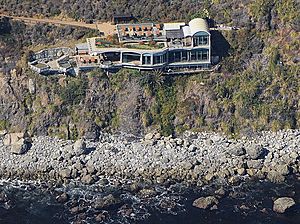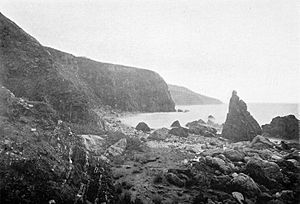Slates Hot Springs facts for kids
Quick facts for kids
Slates Hot Springs
|
|
|---|---|

Aerial view of Slate's Hot Springs and Esalen Institute, 2015
|
|
| Country | United States |
| State | California |
| County | Monterey County |
| Elevation | 118 ft (36 m) |
Slates Hot Springs is a special place in California's Big Sur area. It is famous for its natural hot springs. People have visited these warm waters for a very long time. It is also known by other names, like Big Sur Hot Springs.
In 1868, a man named Thomas B. Slate built a home here. He believed the hot springs helped his arthritis. Soon, other people came hoping the waters would help their health too. Later, in 1910, a doctor named Henry Cloyd Murphy bought the land. His family owned it until 1967. Then, Michael Murphy and Dick Price bought the property. They started a non-profit organization called the Esalen Institute here.
Contents
A Look Back: History of Slates Hot Springs
First People: The Esselen
Long ago, the Esselen people lived along the Big Sur coast. This included the area around Slates Hot Springs. Scientists have found old tools near the springs. These tools show that people were here as early as 3500 BC.
The Esselen people used this site often. It had easy access to the ocean, fresh water, and the hot springs. Some areas were even used as burial grounds. The mountains here are very rugged. This made it hard for many people to live there for a long time.
Sadly, the Esselen population became very small after Europeans arrived. Many were forced to move to Spanish missions. They also got sick from European diseases like measles and smallpox. Many died from illness, hunger, and hard work. This caused 90 percent of the native people to disappear. Today, a few people can still trace their family back to the Esselen. They still have a connection with the Esalen Institute.
Early Settlers and the Springs
In the 1870s, Thomas Slate visited the hot springs. He had bad arthritis and hoped the waters would help. On September 9, 1882, he officially claimed the land. This was done under a law called the Homestead Act. The area then became known as Slates Hot Springs. It was the first place in Big Sur to welcome tourists. Many came seeking relief from their own health problems.
In 1918, a report described the hot springs. It said the water came out in many spots along the bluffs near the ocean. The water temperature ranged from 110 °F (43 °C) to 121 °F (49 °C). It had a slight sulfur smell. The report also mentioned another spring nearby. This one was 98 °F (37 °C) and was used for washing clothes.
It is said that a Native American person told Thomas Slate about the springs. He first found a warm spring by a creek. Later, he came by boat and found the main springs on the bluff. He settled there in 1868.
The Murphy Family Takes Over
In 1910, Dr. Henry Cloyd Murphy bought the land. He was a doctor from Salinas. Dr. Murphy wanted to open a health spa like those in Europe. He planned to do this once Highway 1 was finished. Before the highway opened in 1937, engineers working on the road used the springs.
After the highway was built, World War II started. Gas was limited, and people could not travel for fun. This meant few visitors came to the springs. After the war, different managers ran the resort. It had a restaurant, and people could pay to use the hot spring baths. The business was officially called "Big Sur Hot Springs." However, most people still called it "Slate's Hot Springs."
Slates Hot Springs Today
In 1962, Michael Murphy and Dick Price leased the springs and resort. They leased it from Henry Murphy's grandmother, Vinnie MacDonald Murphy. They wanted to create a place where new ideas could be shared. They wanted a place free from the strict rules of traditional education. In 1963, they officially started their non-profit business. They named it the Esalen Institute. Today, the Esalen Institute continues to use the hot springs for its programs.




